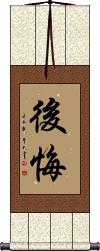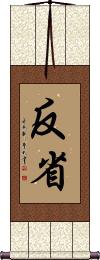Many custom options...
And formats...

Repentance in Chinese / Japanese...
Buy a Repentance calligraphy wall scroll here!
Personalize your custom “Repentance” project by clicking the button next to your favorite “Repentance” title below...
Sorry / Apologetic / Repent / Regret
後悔 is the feeling of being or feeling repentant, apologetic, and regret.
後悔 is not sorrow.
This term is often used in the context of Buddhism and other religions.
Note: This is a strange thing to write on a wall scroll for Chinese, Japanese, and Korean people - but you can bend the rules if you want in the west.
Reflect
反省 is the Chinese, Japanese Kanji, and old Korean Hanja means several things, including reflecting upon oneself, examining one's conscience, questioning oneself, searching one's soul, reflection, reconsideration, introspection, meditation, contemplation, regret, repentance, remorse.
These search terms might be related to Repentance:
Die Without Regret
Learning Leads to Knowledge, Study Leads to Benevolence, Shame Leads to Courage
Live Without Regret
Melancholy / Sorrow
Redemption / Atonement
Sadness / Sorrow
Sense of Shame / Sense of Honor / Integrity / Modesty (Korean)
Sorrow / Feeling Sorry
Sorry / Apologetic / Repent / Regret
Sorry / Feel Apologetic / Regret
Not the results for repentance that you were looking for?
Below are some entries from our dictionary that may match your repentance search...
| Characters If shown, 2nd row is Simp. Chinese |
Pronunciation Romanization |
Simple Dictionary Definition |
反省 see styles |
fǎn xǐng fan3 xing3 fan hsing hansei / hanse はんせい |
More info & calligraphy: Reflect(noun, transitive verb) (1) reflection; reconsideration; introspection; meditation; contemplation; (noun, transitive verb) (2) regret; repentance; remorse; being sorry |
後悔 后悔 see styles |
hòu huǐ hou4 hui3 hou hui koukai / kokai こうかい |
More info & calligraphy: Sorry / Apologetic / Repent / Regret(n,vs,vt,vi,adj-no) regret; repentance; remorse to repent; regret |
懺 忏 see styles |
chàn chan4 ch`an chan sen |
(bound form) to feel remorse; (bound form) scripture read to atone for sb's sins (from Sanskrit "ksama") kṣamayati, "to ask pardon"; to seek forgiveness, patience or indulgence, kṣamā meaning patience, forbearance, tr. as 悔過 repentance, or regret or error; also as confession. It especially refers to the regular confessional service for monks and for nuns. |
事懺 事忏 see styles |
shì chàn shi4 chan4 shih ch`an shih chan ji sen |
repentance through activities |
五悔 see styles |
wǔ huǐ wu3 hui3 wu hui gokai |
The five stages in a penitential service. Tiantai gives: (1) confession of past sins and forbidding them for the future; (2) appeal to the universal Buddhas to keep the law-wheel rolling; (3) rejoicing over the good in self and others; (4) 廻向 offering all one's goodness to all the living and to the Buddha-way; (5) resolve, or vows, i. e. the 四弘誓. The Shingon sect 眞言宗 divides the ten great vows of Samantabhadra 普賢 into five 悔, the first three vows being included under 歸命 or submission; the fourth is repentance; the fifth rejoicing; the sixth, seventh, and eighth appeal to the Buddhas; the ninth and tenth, bestowal of acquired merit. |
仟悔 see styles |
qiān huǐ qian1 hui3 ch`ien hui chien hui |
repentance (in Christianity) |
十心 see styles |
shí xīn shi2 xin1 shih hsin jisshin |
The ten kinds of heart or mind; there are three groups. One is from the 止觀 4, minds ignorant and dark; affected by evil companions; not following the good; doing evil in thought, word, deed; spreading evil abroad; unceasingly wicked; secret sin; open crime; utterly shameless; denying cause and effect (retribution)―all such must remain in the flow 流 of reincarnation. The second group (from the same book) is the 逆流 the mind striving against the stream of perpetual reincarnation; it shows itself in devout faith, shame (for sin), fear (of wrong-doing), repentance and confession, reform, bodhi (i.e. the bodhisattva mind), doing good, maintaining the right law, thinking on all the Buddhas, meditation on the void (or, the unreality of sin). The third is the 眞言 group from the 大日經疏 3; the "seed" heart (i.e. the original good desire), the sprout (under Buddhist religious influence), the bud, leaf, flower, fruit, its serviceableness; the child-heart, the discriminating heart, the heart of settled judgment (or resolve). |
學悔 学悔 see styles |
xué huǐ xue2 hui3 hsüeh hui gakuge |
Studying to repent, as when a monk having committed sin seeks to repent. |
律懺 律忏 see styles |
lǜ chàn lv4 chan4 lü ch`an lü chan ritsusan |
Repentance and penance according to the rules. |
悔い see styles |
kui くい |
regret; repentance |
悔恨 see styles |
huǐ hèn hui3 hen4 hui hen kaikon かいこん |
remorse; repentance (n,vs,adj-no) regret; remorse; repentance; contrition |
悔悛 see styles |
kaishun かいしゅん |
(noun/participle) repentance; contrition |
悔悟 see styles |
huǐ wù hui3 wu4 hui wu kaigo かいご |
to repent (n,vs,vt,vi) remorse; repentance |
悔改 see styles |
huǐ gǎi hui3 gai3 hui kai |
to repent; repentance |
悔法 see styles |
huǐ fǎ hui3 fa3 hui fa ke hō |
method of repentance |
悔過 悔过 see styles |
huǐ guò hui3 guo4 hui kuo ke ka |
to repent; to be penitent To repent of error. |
懺悔 忏悔 see styles |
chàn huǐ chan4 hui3 ch`an hui chan hui sange; zange さんげ; ざんげ |
to repent; (religion) to confess (noun, transitive verb) (さんげ is usu. used in Buddhism and ざんげ in other religions) repentance; confession; penitence chan is the translit. of kṣamā, 悔 its translation, i.e. repentance; but also the first is intp. as confession, cf. 提 deśanā, the second as repentance and reform. |
擯治 摈治 see styles |
bìn zhì bin4 zhi4 pin chih hinji |
The punishment of expulsion, which is of three orders: (1) 擯出 expulsion from a particular monastery or nunnery, to which there may be a return on repentance; (2) 默擯 prohibition of any intercourse; (3) 滅擯 entire expulsion and deletion from the order. |
改悛 see styles |
kaishun かいしゅん |
(noun/participle) repentance; contrition |
服辯 服辩 see styles |
fú biàn fu2 bian4 fu pien |
written confession; letter of repentance |
滅擯 灭摈 see styles |
miè bìn mie4 bin4 mieh pin meppin |
Blotting out the name and the expulsion of a monk who has committed a grievous sin without repentance. |
理懺 理忏 see styles |
lǐ chàn li3 chan4 li ch`an li chan risen |
repentance through principle |
禮懺 礼忏 see styles |
lǐ chàn li3 chan4 li ch`an li chan raisan |
Worship and repentance, penitential offering. |
能悔 see styles |
néng huǐ neng2 hui3 neng hui nō ke |
repentance |
還生 还生 see styles |
huán shēng huan2 sheng1 huan sheng genshō |
To return to life; to be reborn in this world; to be reborn from the Hīnayāna nirvana in order to be able to attain to Mahāyāna buddhahood; also, restoration to the order, after repentance for sin. |
首悔 see styles |
shǒu huǐ shou3 hui3 shou hui |
Voluntary confession and repentance. |
九方便 see styles |
jiǔ fāng biàn jiu3 fang1 bian4 chiu fang pien ku hōben |
The nine suitable stages in religious service; cf. 大日經, 7; 作禮 salutation to the universal Triratna; 出罪 repentance and confession; 歸依 trust (in the Triratna); 施身 giving of self (to the Tathāgata); 發菩提心 vowing to devote the mind to bodhi; 隨喜 rejoicing (in all good); 勸請 beseeching (all Tathāgatas to rain down the saving law); 奉請法身 praying for the Buddha-nature in self and others for entry in the Pure Land; 迴向 demitting the good produced by the above eight methods, to others, universally, past, present, and future. This form of service is generally performed before engaging in esoteric observances. The verses in which these nine stages are presented are of a commendably devotional character. |
事懺悔 事忏悔 see styles |
shì chàn huǐ shi4 chan4 hui3 shih ch`an hui shih chan hui ji sange |
repentance through activities |
作法懺 作法忏 see styles |
zuò fǎ chàn zuo4 fa3 chan4 tso fa ch`an tso fa chan sahō sen |
(作法懺悔) One of the three kinds of monastic confession and repentance. |
取相悔 see styles |
qǔ xiāng huǐ qu3 xiang1 hui3 ch`ü hsiang hui chü hsiang hui shusōke |
repentance according to marks |
Click here for more repentance results from our dictionary
The following table may be helpful for those studying Chinese or Japanese...
| Title | Characters | Romaji (Romanized Japanese) | Various forms of Romanized Chinese | |
| Sorry Apologetic Repent Regret | 後悔 | kou kai / go ke koukai / goke ko kai / go ke | hòu huǐ / hou4 hui3 / hou hui / houhui | |
| Reflect | 反省 | hansei / hanse | fǎn xǐng / fan3 xing3 / fan xing / fanxing | fan hsing / fanhsing |
Successful Chinese Character and Japanese Kanji calligraphy searches within the last few hours...





